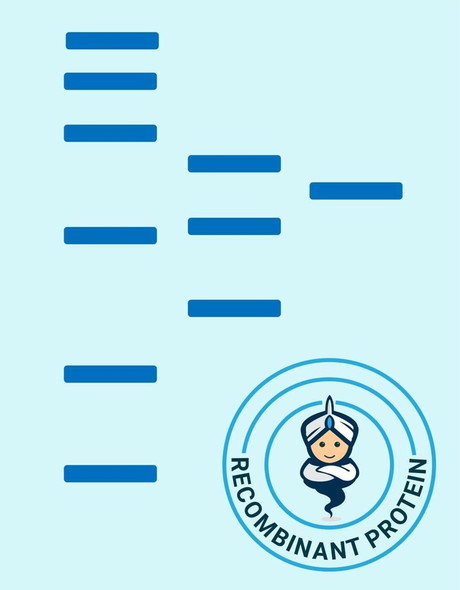Human IFNG 139 a.a. Recombinant Protein (RPPB0399)
- SKU:
- RPPB0399
- Product type:
- Recombinant Protein
- Size:
- 10ug
- Species:
- Human
- Target:
- IFNG 139 a.a.
- Synonyms:
- Interferon
- Gamma
- Immune Interferon
- IFN-Gamma
- Source:
- Escherichia Coli
- Uniprot:
- P01579
Description
| Product Name: | Human IFNG 139 a.a. Recombinant Protein |
| Product Code: | RPPB0399 |
| Size: | 10µg |
| Species: | Human |
| Target: | IFNG 139 a.a. |
| Synonyms: | Interferon, Gamma, Immune Interferon, IFN-Gamma, IFG, IFI,Interferon Gamma 3, Interferon gamma. |
| Source: | Escherichia Coli |
| Physical Appearance: | Sterile Filtered clear solution. |
| Formulation: | IFNG 139 a.a. protein solution (1mg/ml) contains PBSbuffer (pH 7.4), 10% glycerol and 1mM DTT. |
| Stability: | Store at 4°C if entire vial will be used within 2-4 weeks. Store, frozen at -20°C for longer periods of time. Please avoid freeze thaw cycles. |
| Purity: | Greater than 95.0% as determined by analysis by SDS-PAGE. |
| Amino Acid Sequence: | MQDPYVKEAE NLKKYFNAGH SDVADNGTLF LGILKNWKEE SDRKIMQSQI VSFYFKLFKN FKDDQSIQKS VETIKEDMNV KFFNSNKKKR DDFEKLTNYS VTDLNVQRKA IHELIQVMAE LSPAAKTGKR KRSQMLFRG |
IFN-gamma produced by lymphocytes activated by specific antigens or mitogens. IFN-gamma, in addition to having antiviral activity, has important immunoregulatory functions, it is a potent activator of macrophages, and has antiproliferative effects on transformed cells and it can potentiate the antiviral and antitumor effects of the type interferons.
IFNG 139 a.a. Human Recombinant produced in E.Coli is asingle, non-glycosylated, polypeptide chain containing 139 amino acids (24-161a.a.) and having a molecular mass of 16.3kDa.IFNG 139 a.a. is purified by proprietary chromatographic techniques.
| UniProt Protein Function: | IFNG: Produced by lymphocytes activated by specific antigens or mitogens. IFN-gamma, in addition to having antiviral activity, has important immunoregulatory functions. It is a potent activator of macrophages, it has antiproliferative effects on transformed cells and it can potentiate the antiviral and antitumor effects of the type I interferons. Homodimer. Released primarily from activated T lymphocytes. Belongs to the type II (or gamma) interferon family. |
| UniProt Protein Details: | Protein type:Membrane protein, integral; Secreted; Secreted, signal peptide; Cytokine Chromosomal Location of Human Ortholog: 12q14 Cellular Component: extracellular space; extracellular region; external side of plasma membrane Molecular Function:interferon-gamma receptor binding; cytokine activity Biological Process: positive regulation of isotype switching to IgG isotypes; positive regulation of nitric oxide biosynthetic process; apoptosis; positive regulation of interleukin-23 production; negative regulation of smooth muscle cell proliferation; positive regulation of interleukin-12 production; positive regulation of osteoclast differentiation; positive regulation of interleukin-6 biosynthetic process; negative regulation of epithelial cell differentiation; positive regulation of interleukin-1 beta secretion; positive regulation of killing of cells of another organism; negative regulation of transcription from RNA polymerase II promoter; sensory perception of mechanical stimulus; positive regulation of membrane protein ectodomain proteolysis; cell surface receptor linked signal transduction; positive regulation of MHC class II biosynthetic process; positive regulation of cell proliferation; positive regulation of mesenchymal cell proliferation; positive regulation of T cell proliferation; cell cycle arrest; defense response to virus; regulation of the force of heart contraction; positive regulation of peptidyl-serine phosphorylation of STAT protein; response to drug; positive regulation of synaptic transmission, cholinergic; neutrophil chemotaxis; adaptive immune response; CD8-positive, alpha-beta T cell differentiation during immune response; negative regulation of myelination; unfolded protein response; response to virus; cytokine and chemokine mediated signaling pathway; defense response to protozoan; positive regulation of tumor necrosis factor production; humoral immune response; antigen processing and presentation; positive regulation of tyrosine phosphorylation of Stat1 protein; positive regulation of chemokine biosynthetic process; negative regulation of interleukin-17 production; positive regulation of interleukin-12 biosynthetic process; protein import into nucleus, translocation; defense response to bacterium; neutrophil apoptosis; positive regulation of transcription from RNA polymerase II promoter; cell motility; positive regulation of neuron differentiation; regulation of insulin secretion Disease: Hepatitis C Virus, Susceptibility To; Aplastic Anemia; Tuberous Sclerosis 2; Mycobacterium Tuberculosis, Susceptibility To; Human Immunodeficiency Virus Type 1, Susceptibility To |
| NCBI Summary: | This gene encodes a member of the type II interferon family. The protein encoded is a soluble cytokine with antiviral, immunoregulatory and anti-tumor properties and is a potent activator of macrophages. Mutations in this gene are associated with aplastic anemia.[provided by RefSeq, Nov 2009] |
| UniProt Code: | P01579 |
| NCBI GenInfo Identifier: | 124479 |
| NCBI Gene ID: | 3458 |
| NCBI Accession: | P01579.1 |
| UniProt Secondary Accession: | P01579,Q53ZV4, B5BU88, |
| UniProt Related Accession: | P01579 |
| Molecular Weight: | |
| NCBI Full Name: | Interferon gamma |
| NCBI Synonym Full Names: | interferon, gamma |
| NCBI Official Symbol: | IFNG |
| NCBI Official Synonym Symbols: | IFG; IFI |
| NCBI Protein Information: | interferon gamma; IFN-gamma; immune interferon |
| UniProt Protein Name: | Interferon gamma |
| UniProt Synonym Protein Names: | Immune interferon |
| Protein Family: | Interferon |
| UniProt Gene Name: | IFNG |
| UniProt Entry Name: | IFNG_HUMAN |






